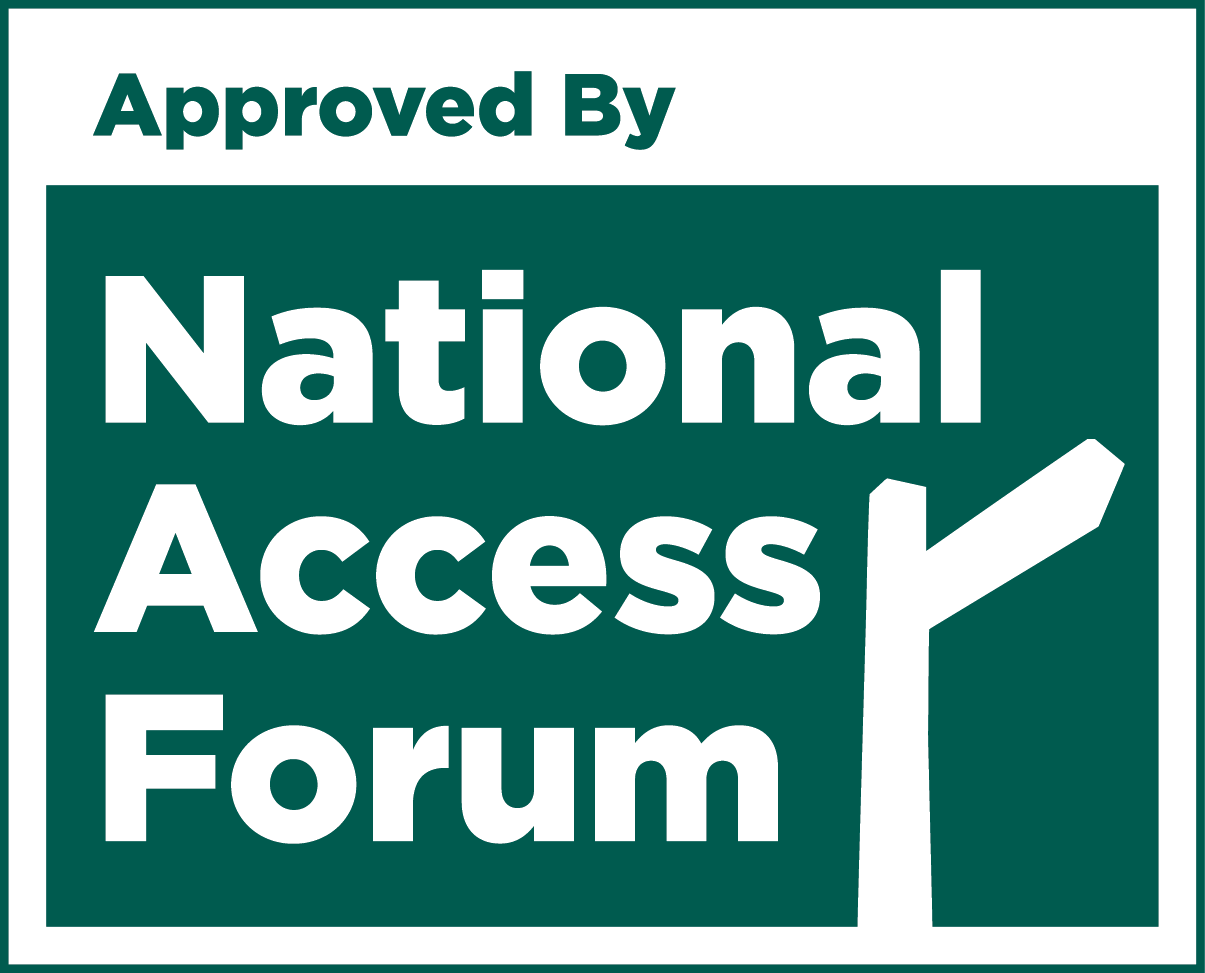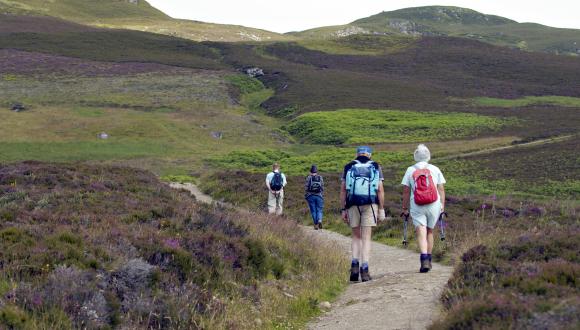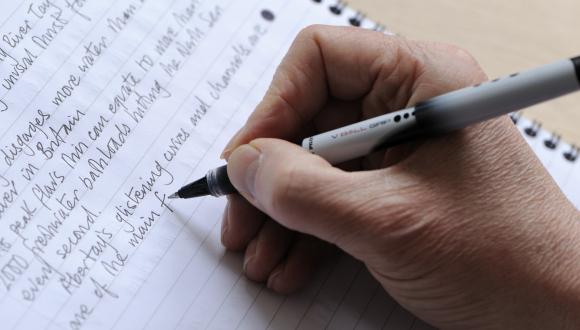Guidance - Open fires and BBQs in the outdoors
Advice for people involved in managing the public outdoors including land managers, rangers and visitor managers.
Purpose of this guidance
To provide advice and practical information which recognises the longstanding appetite for people to have fires in the Scottish outdoors.
The guidance acknowledges that people might light fires for a range of reasons: to keep away midges, to toast marshmallows or cook sausages; or as a focal point for social gathering. Knowing where, when and how to manage a fire safely is a skill – as is when NOT to light a fire.
It highlights the Scottish Outdoor Access Code, the law and regulatory options, communications and engagement approaches, issues that can arise and visitor management tools.
The "Managing public access in areas of wildlife sensitivity in Scotland" guidance may also help.
Who is the guidance for?
People involved in managing the public in the outdoors, including rangers, wardens, visitor managers, forest managers, access professionals, outdoor activity providers and organisations, land managers and landowners.
Typically, in places such as country parks, estates, nature reserves, forest parks, the water’s edge and wider countryside in Scotland.
Contents
- Purpose of this guidance
- What types of recreational fire and BBQ activity does the guidance cover?
- So, what is the problem?
- Fire focused organisations
- Visitor management principles
- Communications and Engagement with the public
- Fires messaging framework
- Infrastructure, services and management
- Regulation, laws and rules - fires and fire lighting
- Acknowledgements
What types of recreational fire and BBQ activity does the guidance cover?
There are many ways that the public engage in fire lighting activity from the more “traditional” open fire set in a ring of stones, to equipment designed specifically to have a fire or BBQ in/on e.g. mesh stands and collapsable lightweight fire bowls. This guidance is primarily looking at open fires and BBQing activity that can cause issues or concerns in an outdoor environment. Items such as gas BBQs, camping stoves and kelly kettles are, if used properly, seen to be safer and more contained and can provide an alternative to having a fire in some situations.
BBQs come in many forms:
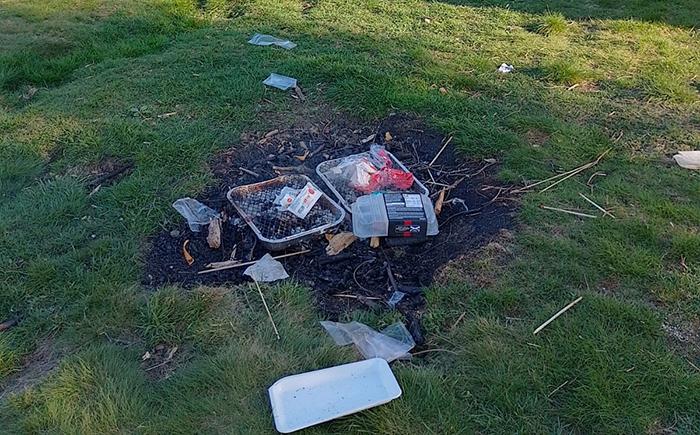
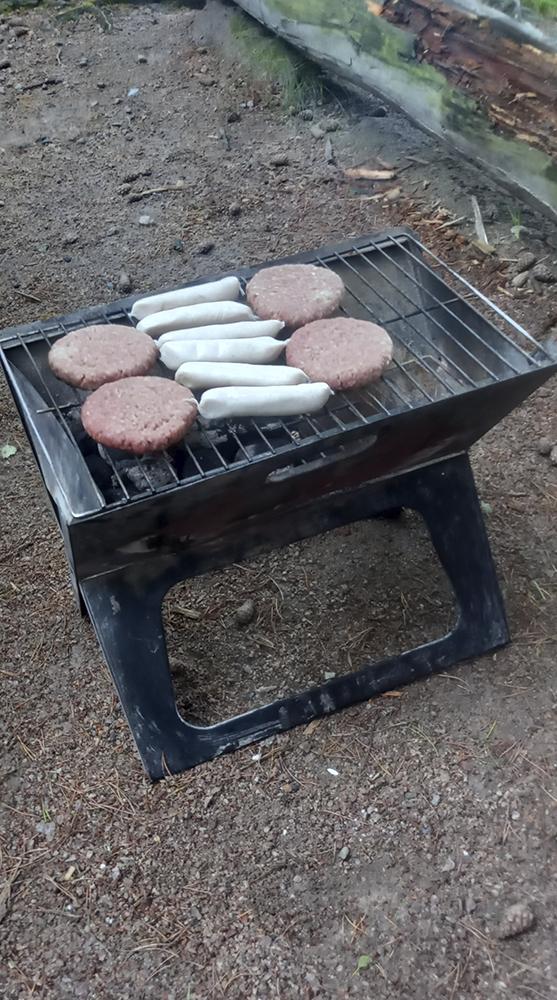
As do open fires:
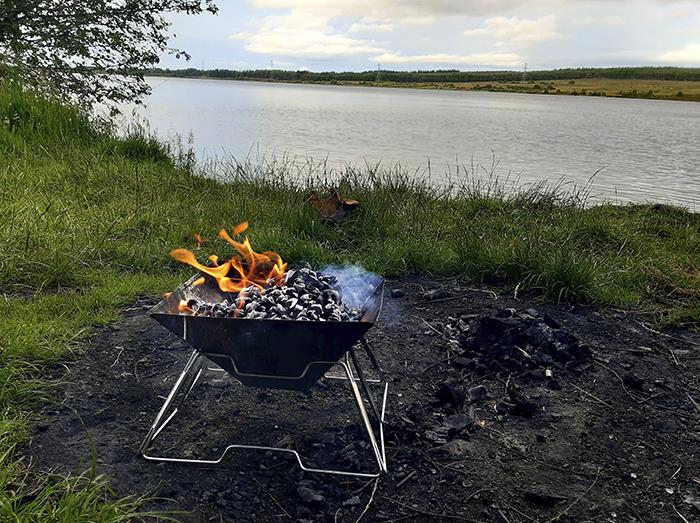
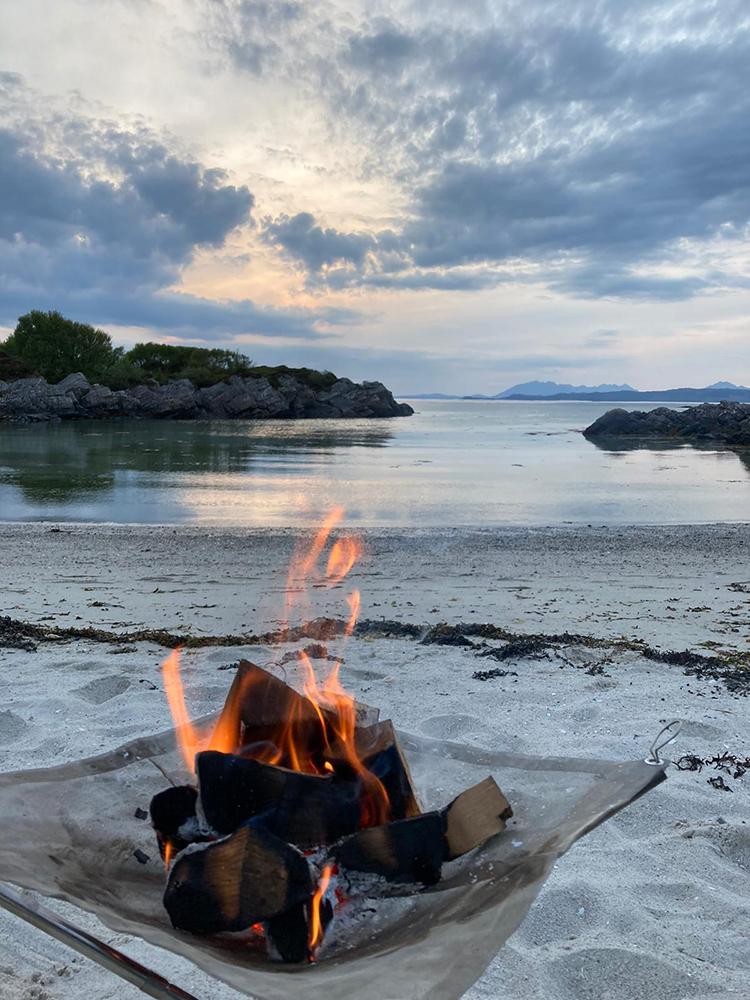
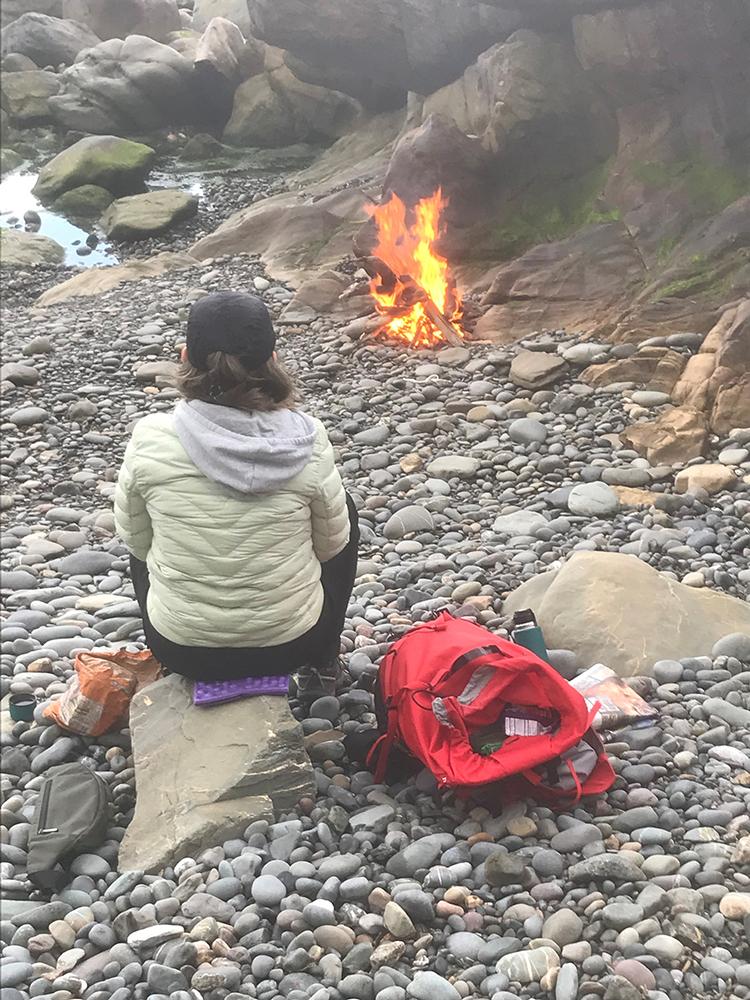
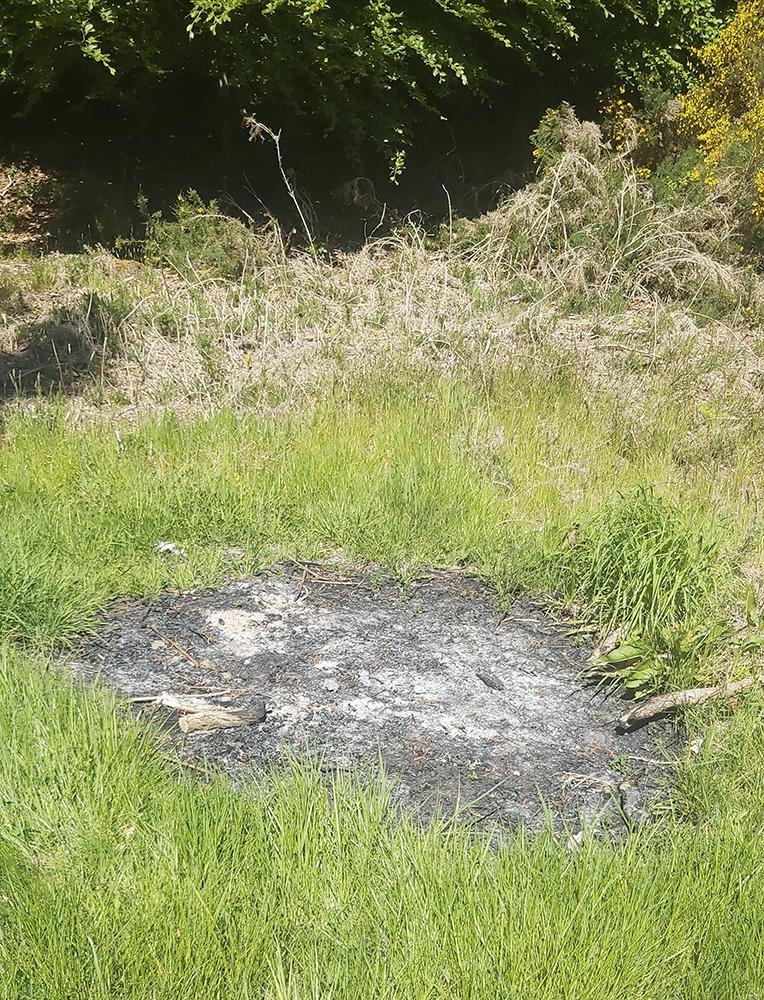
The type of recreation and leisure activities commonly associated with having a fire or BBQ in the outdoors are wide ranging and include picnicking, camping, fishing, adventure activities (hiking, bike packing, boating…).
These activities are undertaken by the public, visitors from home and abroad and can be part of more formal activities undertaken by Scouts and Guides, outdoor nurseries, outdoor education and learning providers as well as commercial outdoor activity providers.
A note about - Muirburn and controlled burning
Muirburn guidance for landowners and land managers, including detail on statutory restrictions, can be found in the Muirburn Code.
Muirburn is the seasonal burning of heather undertaken deliberately by land managers to create a mosaic of heather patches of different ages benefiting grouse and other grazers. Burning is carried out by trained professionals with fire management equipment. Other forms of controlled burning sometimes take place such as gorse and grassland. The standard season for muirburn is 1 October to 15 April to avoid harm to moorland birds that nest in spring as well as reptiles coming out of hibernation.
It is possible that you might be managing visitors and restricting fires and BBQs whilst muirburn may be taking place in the same area. If this situation arises it is essential that you provide clear messaging for the public and explain the reasoning, whilst also being aware that muirburn activity itself could lead to a wider or uncontrolled fire. If in any doubt, contact the Scottish Fire and Rescue Service.
So, what is the problem?
The lighting of fires and having BBQs in a countryside setting has been a part of the public’s enjoyment of the outdoors for decades. However over recent years there have been heightened concerns about risks from a range of factors coming together, including: the availability and use of new types of fire related equipment, increased numbers of people taking part in recreational fire lighting, concerns about the potential and real impacts of fires on the environment and nature, public safety concerns and emerging inconsistencies in management approaches, communication and engagement with visitors.
Climate change is having an impact on our weather patterns with more extreme or significant weather events that can result in drier and more volatile conditions and a higher fire risk. This is being evidenced in Scotland and globally with some extremely significant wildfire incidents.
A key concern is visitors being the source of ignition by having fires and or BBQs at times and in places where there is a high or extreme risk of causing a wildfire that could damage or destroy land, infrastructure and buildings, wildlife and habitats and be a danger to the public.
Areas at particular risk include places that have had a period of dry weather and have a volatile fuel source, such as forestry and woodland, grassland, heather and peat. Times such as late winter, early spring, when dead grass is dried out and no new growth has started or periods of hot dry weather that kills off grass and vegetation, dries out the woodland understorey and moorlands during spring and summer months.
In the context of outdoor recreation and visitor management the most popular locations for having a fire or BBQ tend to be loch shores with a woodland edge or backdrop and beaches and adjacent grassy areas, dunes or woods. And in places attractive to visitors for activities such as picnicking, social gatherings, fishing and camping.
Another factor is that issues often arise in places where there is no safe and formal provision for fires or BBQs. There are some formal settings such as picnic areas, country parks, managed camping areas/permit zones and parking areas that do provide managed provision, in particular for BBQs e.g. raised metal plates on picnic benches.
Surveying and monitoring work undertaken by rangers and operational staff from across Scotland confirms that fires and BBQs continue to be a problem. The data is collected seasonally as part of the national Visitor Management Co-ordination Group’s work and Action Plan delivery.
Fire focused organisations
The lead experts in fires and fire prevention and safety are the Scottish Fire and Rescue Service as the national agency. If you have issues with fires it is essential to work with SFRS, you can contact them via their website for advice and support.
Scottish Fire and Rescue Service
Working together for a safer Scotland and committed to ensuring the safety and wellbeing of the people of Scotland. SFRS are trained to deal with fires when they happen, but they also have a key role in fire prevention including fire risk in the outdoors and countryside.
SFRS are involved in delivering fire safety messages, and work with partners in doing this including the Scottish Wildfire Forum.
The SFRS have developed a Wildfire Strategy aimed at enhancing the capability to manage and mitigate wildfires across Scotland. It highlights the SFRS commitment to improving wildfire prevention, response, and partnership efforts, ensuring both local communities and natural landscapes are better protected.
Key Areas of the Wildfire Strategy
The Wildfire Strategy focuses on four key pillars: Partnership Working, Provision of Information, Prevention, and Response.
- Partnership Working and Information Sharing: working closely with the land management sector and other agencies to ensure a unified approach to wildfire prevention. This includes fostering a shared understanding of Muirburn and prescribed burning practices, alongside utilising the collective expertise of partners for prevention education and intervention when needed.
- The Scottish Wildfire Forum plays a key role in raising awareness and sharing knowledge. Through the Wildfire Danger Assessments provided by the SWF, informing Tactical Advisors and the public about wildfire risks using social media and traditional outlets.
- Prevention: In 2024 wildfire prevention materials were developed and the wildfires section of the SFRS website was expanded from a single page to seven detailed theme pages; along with a 22-week prevention campaign.
- Response: The Wildfire Strategy launched in 2023 and is backed by a £1.6 million investment over three years. This includes acquiring all-terrain vehicles (ATVs), trailers, specialist equipment, and four 4x4 support vans, which will be deployed as part of a comprehensive response package.
For more information about SFRS work, advice, leaflets and contact details visit the SFRS website.
Scottish Wildfire Forum
Working to raise awareness and minimise the impact of wildfire in Scotland. The SWF is a group of professionals and practitioners aiming to better understand wildfire, develop understanding and capacity to manage it and minimise the harm it can cause to people and places.
The purpose of the SWF is to create a focus for joint working between all interested stakeholders within Scotland to develop wildfire initiatives that will reduce:
- the risks to firefighters and members of the public
- the amount of damage to vegetation and biodiversity
- the negative impact on property, assets and ecosystem services
For more information about SWF and fire danger assessments visit the SWF website.
Visitor management principles
The main principles associated with good visitor management can be used to help address issues or concerns resulting from the public having recreational open fires and/or BBQ activity. They are all important and should complement each other with the third largely used as the “last resort” if education, engagement and infrastructure/services haven’t been effective.
- Education and engagement – communication methods designed for the audience(s) and planned.
- Infrastructure and services – in the right place, make it easy to do the right thing.
- Regulation and rules – prevention first, enforcement of laws and rules last resort
Remembering to consider these in the wider context of visitor management:
- the visitors experience – understanding the visitor’s expectations
- conservation and protection of nature, land and features
- understanding community views – including landowners, businesses and residents
- evidence of the issues, impacts and concerns
- discussing and working collaboratively
- targeted measures and evidence-based actions
- flexible approach and ability to adapt
- clear and effective communication
- monitoring, reviewing and improvements
Communications and Engagement with the public
What is good communication?
The key to good communication is being clear what it is you are trying to achieve and designing the best way of doing this based on knowing who your audience is and the behaviours you wish to influence or change. Then developing the messages and mechanisms for communicating.
There are a wide spectrum of communication methods and techniques to use, we will focus on:
- face to face engagement
- infrastructure
- digital media and communications
Before leaping ahead with a new “no fires” sign and a quick social media post it is important to consider things more fully.
NatureScot produced guidance back in 2004 based on the work of James Carter (Communication, not conflict:) which is still relevant today and can help inform communications and engagement activity alongside other actions for managing fire and BBQ activity. There are 4 key points to remember:
- Our behaviour is influenced by our personal attitudes and beliefs and by social norms; the attitudes and behaviour considered by people we respect and trust. Persuasive communication must target these root causes of behaviour rather than simply present information.
- Different people have different sets of attitudes and social norms. Successful persuasive communication is based on a thorough understanding of your target audience.
- Effective communication must:
- Provoke: catch and hold its audience’s attention
- Relate: by using style and language meaningful to the audience
- Reveal: have a clearly defined idea or message, rather than presenting a loose collection of facts.
- Communication activities should be planned so that they:
- Address a clearly defined issue
- Are designed for a clearly defined and specific audience
- Involve the people concerned
- Recognise and take account of everyone’s concerns
Face to face engagement
Talking to people is the most effective form of communication with opportunity to discuss, address concerns and question the information and advice being given. The benefits of using on-site staff to convey fire and BBQ related information and advice cannot be under-estimated. Rangers, site wardens, land managers and volunteers can all have a role, utilising good techniques that keep staff safe, avoid conflict and lead to a constructive and positive engagement process.
Preparing staff for difficult conversations or potentially threatening situations is essential. This should include mediation or conflict resolution training which provide techniques and advice on staying safe. Equally, developing skills around customer care and welcoming visitors can help ensure a positive and helpful conversation adding to the visitor experience.
Working with PoliceScotland officers and Scottish Fire & Rescue Services staff may be an option for joint patrolling in areas or times when the fire risk is high or extreme. They may also have access to special constables or volunteer fire wardens. Patrolling provides a direct contact with the public who are having, or thinking about having, fires or BBQ’s and can prevent fire damage and wildfires whilst getting the message across about why it is important.
Further advice and support:
- Scottish Mediation
- Scottish Outdoor Access Network
- Scottish Countryside Rangers Association
- National Farmers Union Scotland
- Scottish Land and Estates
Delivering outdoor activities, education and learning
NatureScot has developed generic SOAC education and outdoor learning activity packs for use by teachers, outdoor learning leaders and activity providers. For specific guidance on having fires as part of a formal outdoor activity, outdoor education and outdoor learning group check out the resources section on the Outdoor & Woodland Learning Scotland website, and search for fires.
SOAC educational activity resources – for those involved in teaching or leading children and young people.
Physical infrastructure – signs
Signs, information panels, digital variable message signs at the roadside and banners are among the many options for catching the eye of the public as they approach your area or site, or once they arrive and start moving around it. Used to advise, inform and warn the public about what is expected of them and of any risks. Also consider as a way to more subtly “nudge” the public towards signs, away from sensitive areas etc.
One of the most visible communication tools used to inform the public is the “no fires” sign. Signage design, build and placement requires careful thought and planning and should form part of a wider communications plan and visitor management plan.
Walking Scotland have updated their 'Signage guide' for the outdoors and it is an essential read before developing your plans.
Some of the common issues with fires and BBQ signage:
- Out of date signs or signs stating “high fire risk” – left up all the time
- Signs in poor condition
- Badly placed and not visible, or visible too late
- Information too long or unclear
- Contradictory e.g. no fires but BBQ plates on picnic benches.
And consider different forms of signage:
- Road-side digital “variable message signs” fixed or mobile which can also be hired, essential to work with your roads authority if planning for roadside use.
- Bespoke signage with flip down panels on fixed signs for use at times of high fire risk, or during peak busy times, temporary banners, bespoke designs.
- Use of vinyl graphics on vehicles or paint graphics on path/road surfaces
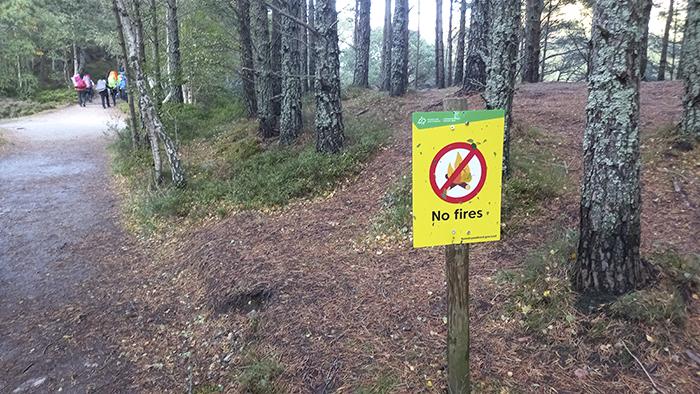
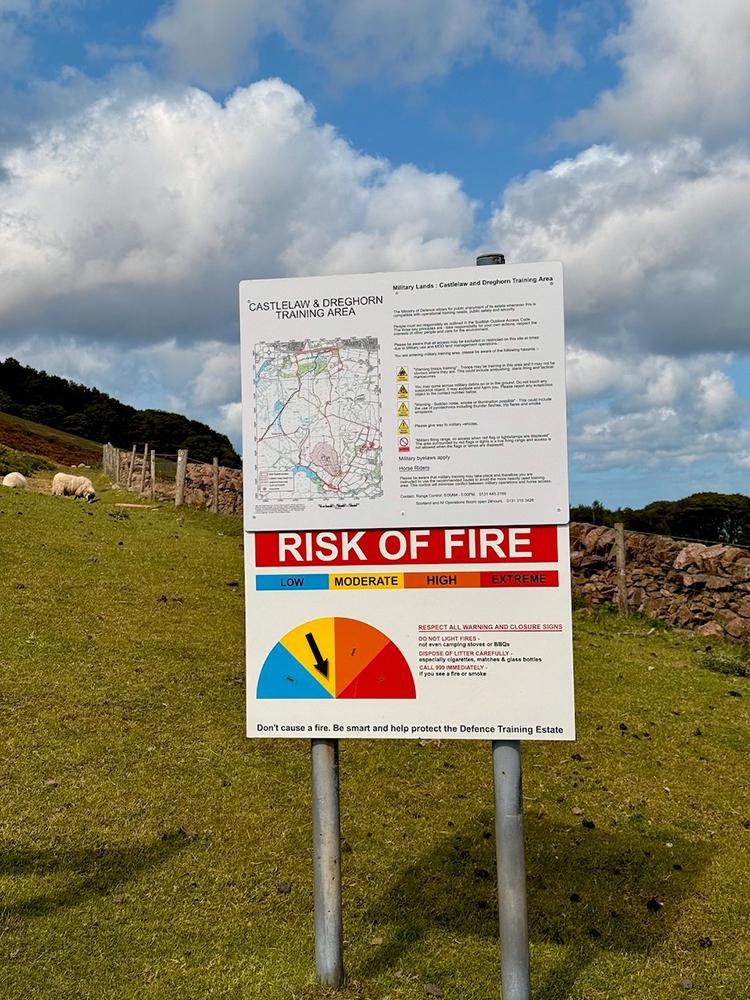
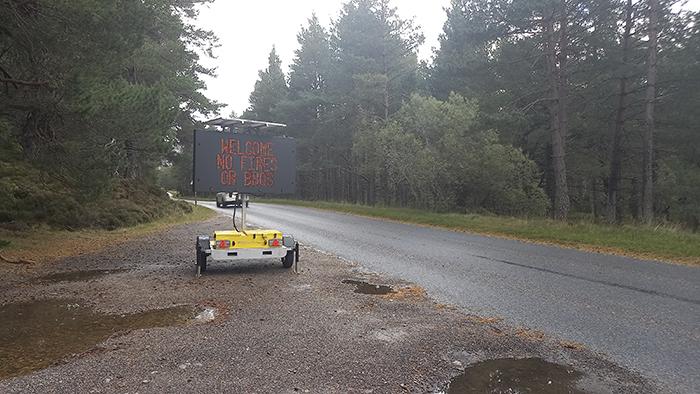
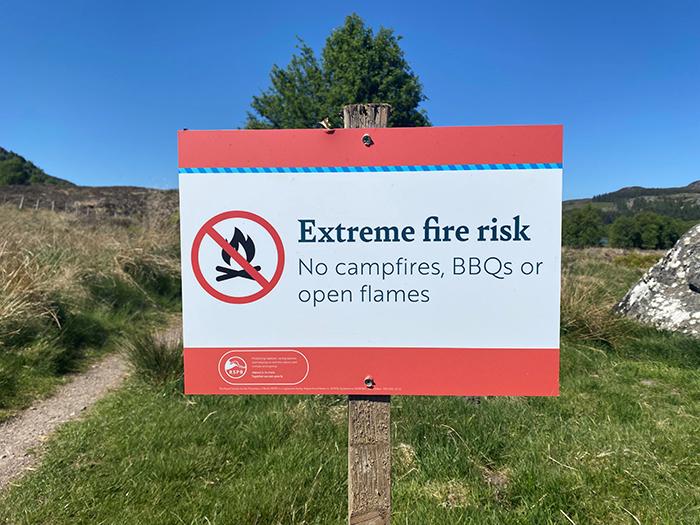
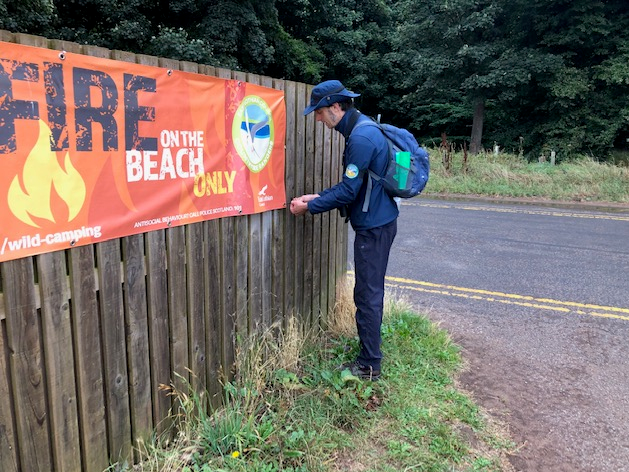
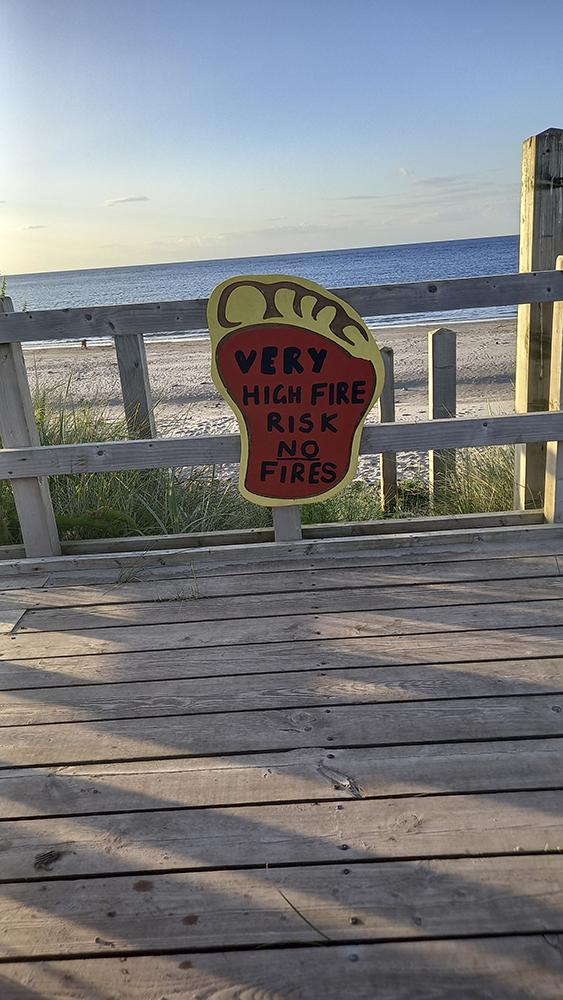
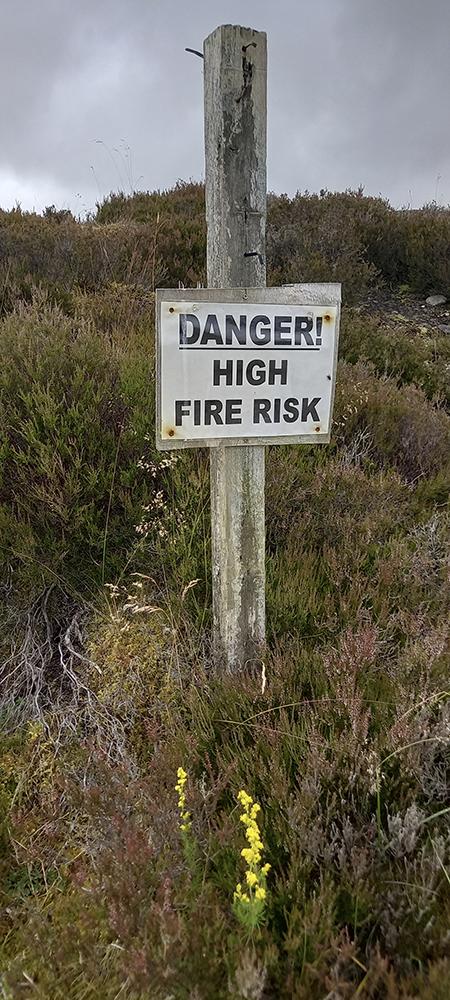
Digital media
Digital media offers a cost-effective approach to delivering clear guidance about responsible behaviour in Scotland's outdoors. Through social media and web content, diverse audiences can be reached across multiple platforms whilst keeping production costs relatively low compared to traditional media.
It is important to adapt the content to the audience and channel. For example, recent research has shown that young audiences get much of their information from social media, but most won't follow an organisation's channels directly, and video is becoming increasingly popular. In this situation, it may be beneficial to target them using voices they enjoy hearing from, can relate to, and trust. Collaborating with partner organisations, outdoor enthusiasts and influencers who already have established audiences on channels such as TikTok and Instagram and are experienced in producing short-form video is one effective approach, particularly when they can demonstrate how to follow the guidance.
Longer-form text content on web pages and channels such as Facebook can outline practical actions people should take and the rationale behind it, without assuming prior knowledge, for example addressing confusion about the use of dead wood. The use of impactful photography can drive key messages home visually on channels such as Instagram, with images for both the positive and the negative, for example the devastating consequences of wildfires, or safe BBQing practice.
All digital content should be designed with accessibility in mind, including captions for videos and alternative text for images, ensuring the information reaches everyone, including those with disabilities.
While digital media provides broad reach and engagement metrics, measuring actual behaviour change remains challenging. Regular analysis of which content performs best can help refine messaging and targeting.
Case Studies
- Ramblers Scotland - Youtube short - Why stoves beat BBQs or fires
- Ramblers Scotland - Youtube short - Responsible wild camping – includes advice on fires
- Forestry and Land Scotland - Wildfire prevention - web page-based information for the public
Fire related communications
There are a number of specific sources of advice that relate to fires and how to communicate with the public. The three we are highlighting are:
- Visitor Management Group - Fires messaging framework – prepared by the national visitor management co-ordination group and endorsed by the National Access Forum.
- Scottish Outdoor Access Code – advice on fire lighting
- Scottish Fire and Rescue Service fire risk advice – generic
And noting that Cairngorms National Park Authority are currently progressing seasonal Fire Management Byelaws subject to ministerial approval.
- Cairngorms National Park – Proposed Fire management byelaws and advice to public
Fires messaging framework – Visitor Management Group
The fires messaging framework has been developed to clarify and encourage consistency in the use of national messages, whilst recognising that organisations and managers would have their own circumstances to accommodate at a local or operational level. It was identified as a priority for action by the Visitor Management Co-ordination Group and has been endorsed by the National Access Forum.
The fires messaging framework provides simplified and prioritised messages for 3 scenarios that align with access rights and the Scottish Outdoor Access Code and wider visitor management challenges. It should be included as part of any wider communications planning and activity, and forms one strand of visitor management.
Case study
Loch Lomond & The Trossachs National Park Responsible visiting toolkit – fire safety in the National Park social media graphic and leaflet.
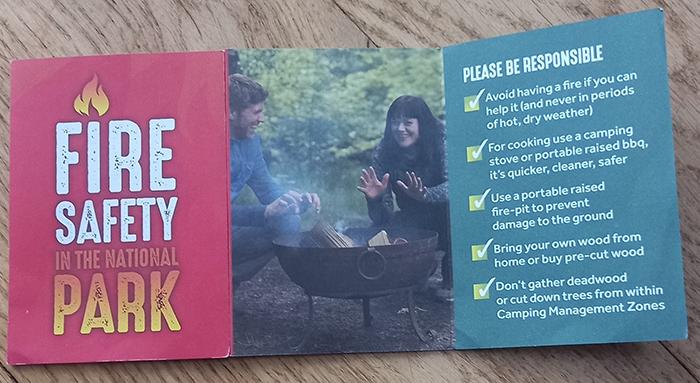
Scottish Outdoor Access Code - Promoting responsible behaviour – fires
NatureScot has a statutory duty to publicise and promote the Code and has a rolling communications campaign promoting responsible behaviour at a national level. The campaign uses web content, radio advertising, paid-for and organic social media, and collaboration with influencers. There are also a variety of resources available for use in local campaigns utilising social media, including graphic tiles depicting camping and fires scenarios, and signage templates.
Case Study
Exploring the outdoors with Calum Maclean – NatureScot commissioned social media
Scottish Fire and Rescue Service – wildfire risk
During times of a high threat of wildfires the SFRS initiates national communications to alert the public and partners of the fire danger including information about the category of risk e.g. Extreme or Very High, a map of the geographic areas at risk and the time period they apply to.
Fires messaging framework
The increasing concern over wildfires led to the Visitor Management Co-ordination Group updating the fires messaging framework in 2024. The framework has been approved by the Visitor Management Strategic Steering Group and the National Access Forum.
The framework provides a clear basis for fire messaging that is aligned with the Scottish Outdoor Access Code and other legislation.
The framework gives options for use in visitor management related communications activity across Scotland leading to a consistency in approaches. The framework will be used by the national Visitor Management Education and Marketing subgroup (provides a coordinated approach to campaigns relating to SOAC and visitor management) and anyone involved in managing and engaging with visitors in the outdoors.
Fires messaging
The 2 status approach is:
No fires
Scenario A – no fires in habitats/sites of fire risk at any time
Scenario B – no fires at times of high or extreme fire risk
Fires
Scenario C – Fires provided for, managed or within access rights
Note that scenario B will over-ride scenario C at times of high or extreme fire risk.
The messaging options for each scenario are set out below.
No fires – Scenario A – no fires in habitats/sites of fire risk at any time
For use at any time and relating to these specific situations, i.e. habitat and site-specific areas that carry a year-round fire risk or at risk of damage due to fire (SOAC lists types/areas) and communicated as appropriate:
- National and local message options for use in all types of communication media e.g. socials, print etc.
- National and local signage messages for use on site-based signs, roadside variable message signs (character count limit) etc.
Fire risk – applies all year
National and local messaging
Pro-active message:
- No fires, BBQs or fire bowls in areas such as forests, farmland, or on peaty ground.
- No fires, BBQs or fire bowls near buildings, or in cultural heritage sites.
- Follow local advice provided.
Signage messages
For use in the following areas/location types at any time of year:
- forests/woods
- farmland
- on peaty ground
- near buildings
- in cultural heritage sites
Wording options:
- No fires
- No fires or BBQs
Symbol examples:
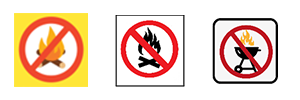
No fires – Scenario B – no fires at times of high or extreme fire risk
For use at times of high or extreme fire risk (SOAC refers to prolonged dry periods) and communicated as appropriate:
- National and local message options for use in all types of communication media e.g. socials, print etc.
- National and local signage messages for use on site-based signs, roadside variable message signs (character count limit) etc.
High or Extreme fire risk
National and local messaging
Pro-active message option:
- Never light a fire (including portable fire bowls/meshes and/or BBQs) at times of high fire risk.
Live message option:
- High Fire risk – do not light a fire (including portable fire bowls/meshes and/or BBQs)
Signage messaging
Wording option 1:
- High fire risk
No fires
Wording option 2:
- High fire risk
No fires or BBQs
Symbol examples:

Fires – Scenario C – Fires provided for and managed or under access rights
Adaptable messages for use where fires are provided for and managed or can be had responsibly under access rights. Will normally not apply in habitats or sites covered in Scenario A, and not at times of high or extreme fire risk, Scenario B.
Positive messaging to ensure the public know what to do in circumstances when or where they can responsibly have a fire.
- No signage design is provided as the relevance and/or appropriateness of the messages in respect to location and provision will vary from place to place, as will communication methods.
- Include a link to a fire risk website/webpage if available ***
- Option to incorporate the SOAC banner.
Low fire risk
Local or site-based messaging
Locations/sites that can provide for or accommodate fires/BBQs e.g. beaches/shoreline.
Amend to reflect local circumstances:
Never have a fire at times of high or extreme fire risk. But at other times if it is safe to do so:
- Follow any local advice on signs or from (rangers)
- Use a portable raised fire bowl/mesh stand or BBQ stand
- Use areas provided for (BBQs/Fires).
- Bring (your own wood/or use wood that is provided…)
- Don’t gather deadwood or cut down trees
- Keep fires small, under control and supervised
- Dispose of used matches responsibly.
- Ensure the BBQ/fire is fully extinguished before leaving
- Dispose of BBQ/fire ash in (e.g. metal bins provided)
- Leave no trace
To find out what the current fire risk is in the area you are visiting: www.***
Infrastructure, services and management
Fires and BBQing are one element of activity that may be having an impact over an area, at a specific site, in a park, picnic area etc. but there are potentially going to be other issues such as litter, camping, parking and toileting depending on the location. Either way it is best to undertake a wider visitor management approach and consider all the factors that may be at play. The first part of this approach, before deciding exactly what actions are required, is careful consideration of the issues based on good evidence. Consider:
- Types of issues – e.g. fire damage to grass, BBQ scorch marks, fire ring creation, firewood collection etc.
- Location of issues - where, habitat types, wildlife, designations, other land use types, forestry, farming, roads, parking, access/egress points etc. Information is best presented in a mapping or site plan form.
- Visitor profile – types of recreational users (including commercial and outdoor activity providers), numbers, how and when the area is used, the problems and how the issues arise. This information may be gathered from direct observation, ranger patrol data, visitor surveys and consultation with users.
- Existing visitor infrastructure and management measures – review any provision for fires/BBQs, fuel supply (formal or otherwise), extinguish/disposal arrangements, safety equipment, zoning, communications (signage/leaflets/info panels), patrolling, other services, fire risk assessments etc. Progress this as part of a review of any existing plans and any other issues.
- Impacts - on others enjoyment including those living in an area, on land management operations and activities, frequency, duration, times, type and extent of damage, disturbance, damage to vegetation etc. Also note any recovery time for vegetation if applicable.
Site or area-based planning and design
The range of outdoor settings which may experience fire or BBQ activity is varied:
- Managed countryside sites: parks, picnic areas, viewing areas, camping areas/permit zones.
- Laybys, informal parking, waters-edge camping/fishing spots, car parks, beaches, viewpoints etc.
Having a fire or BBQ often forms part of wider recreational activities such as camping, fishing or picnicking. In developing plans and actions to manage fires and BBQ activity it is important to consider all the factors such as:
- how visitors arrive to site
- group size/numbers
- what transport they use
- other activities/interests e.g. social event, fishing, swimming
- times and duration of visits
- movement and other places visited
- other users of the area
Use of infrastructure
The provision and location of infrastructure associated with fires or BBQing can greatly influence people’s use of the site. Equally it is important to ensure that any infrastructure or new proposals do not detract from the very reason people visit the area. New developments should take account of or be included within local place plans, master plans, strategic tourism development plan and fit with planning policy. They must comply with any other regulatory requirements.
Depending on the approach required which will typically either be to discourage fires and take a no fires/BBQ approach or to pro-actively provide for them in appropriate places, will influence what infrastructure and services you might provide, where you provide them and how you manage them. BBQs may be seen as less of an issue in some locations, or open fires may be the biggest area of concern e.g. sites close to or in woodland.
Pro-active and direct formal provision might include:
- BBQ stands, BBQ plates on benches
- Gas BBQ provision
- Fire bowls, fire pits or formal fire rings
- Logs and kindling supplied
- Fireproof bins for safe disposal of ash and hot coals
- Bins for disposal of food waste/rubbish
- Extinguishers – water/sand
- Safety advice and signage
- Site cleaning and maintenance
- Designated safe areas or zones for BBQs or fire stand/bowl use e.g. beach or hard-standing
The inclusion of appropriate supporting infrastructure to facilitate movement to and around a site or area is important to ensure that any fire or BBQ related provision is easy and attractive to use. The location of paths, roads, parking areas, orientation signs, directional signs, advisory/warning signs, camping areas, toilets, bins, picnic areas, etc. can contribute to a site working well.
The placement of infrastructure can be used to draw people away from areas of fire risk or sensitivity, using a zoning approach to visitor management, with due care not to restrict the responsible exercise of access rights or to unintentionally displace visitors to other sensitive areas or sites. These approaches can pre-empt potential problems by influencing visitors passively, with no need for conscious behavioural decisions on their part. While this is a fundamental visitor management tool, there can be limitations to this approach, such as practicalities based on a site’s physical constraints e.g. size, topography, or affordability. There may also be a requirement for more staff to be on site or patrolling.
It is important to review how any existing infrastructure is used to learn and make improvements if required such as adaptations or relocation or removal.
Site restoration and recovery
There will always be an impact of having an open fire on vegetated ground, unless a suitable raised fire bowl or similar is used. Scorch marks at the least and potentially more depending on size and duration of the fire e.g. burning down into peat or setting grass, heather or trees alight. In some situations, the cumulative impact can result in significant damage to the ground vegetation, or the base of trees where fires are lit in the shelter of the tree trunk. There can be other damage and impacts to an area from the gathering of firewood by cutting off live tree limbs, breaking branches and gathering of deadwood.
One approach used to address damage is a temporary exclusion zone around the scorched/damaged ground to allow the vegetation to recover. The re-seeding of areas can speed this up. Keeping any cordoned off areas small and well signed with a positive explanation can improve the chances of the roped off areas or fencing staying in place.
People are more likely to have fires where there have been fires, so if the location is an area where fires are causing damage, removing any signs of previous fires such as stone fire circles and restoring scorch marks is very important to do as soon as possible.
The Highland Council have successfully used the exclusion zone technique on a number of small sites.
Operational management
The management of a site or area is a really important component of visitor and access management. This is all the work that takes place to ensure people and places are looked after properly. This can include everything from rangers patrolling sites, putting up signage, fire prevention, site maintenance, litter picking, bin emptying, opening/closing gates, restoration work, community and landowner liaison etc. How it is undertaken will vary with activities undertaken in partnership (other agencies/community/businesses/landowners), contracted services, joint patrols, vehicles, sharing intelligence, use of volunteers etc. The use of standard operation procedures, risk management and other processes are required to ensure safe working practices and to ensure public safety. This is particularly relevant if staff are required to deal with fires.
The level of operational management will be dependent on available resources, and challenges faced might include size of area/sites to cover, remoteness of an area, availability of seasonal staff, experience, skills and knowledge, and most challenging is when issues occur everywhere all at the same time with short notice e.g. when the sun shines, warm temperatures and over a weekend. Deployment plans need to include arrangements for high fire risk and/or peak visitor times, noting that critical engagement times tend to be evenings and weekends and include the involvement of support services such as Police Scotland and Scottish Fire and Rescue Service. Planning in advance is key, being flexible and doing joint scenario planning for peak times/places, fire incidents etc.
Ensuring good working relations and communication between agencies is key, particularly for frontline staff such as rangers/wardens and for land managers and primarily with the emergency services police and fire and rescue. There are benefits to this on both sides with help and support to deal with a fire incident, but also in the prevention of fire through the management of open fires and BBQ activity. The general sharing of intelligence from those working on the ground and across areas is invaluable. As well as linking in with communications work such as social media messaging about fire danger.
Regulation, laws and rules - fires and fire lighting
There are several pieces of legislation that relate to lighting fires in the outdoors, the following are the ones we think are most relevant to managing visitors and access. The laws are complex and there are other factors to consider in how they relate to each other and the effects of legislative amendments and recognising that legislation has not necessarily been designed with outdoor recreation and enjoyment or visitor management issues in mind but often for specific circumstances particularly around public safety, damage to property and road safety. As a result, there are no direct references to the Scottish Outdoor Access Code and no references to or definitions for BBQs. There are enforceable offences associated with having a fire, depending on the circumstances.
We recommend seeking your own legal advice if in any doubt about what or how the law applies to your circumstances.
A brief guide to laws relevant to outdoor access in Scotland
Land Reform (Scotland) Act 2003 and the Code
Part 1 of the Land Reform (Scotland) Act 2003 gives statutory access rights to most land and inland water, subject to them being undertaken responsibly. The Scottish Outdoor Access Code provides the guidance for those exercising access rights and for those managing land and water. The Land Reform Act also makes a significant amendment to the Trespass (Scotland) Act 1865 to allow fires if using access rights as guided by the Code. The Code states the types of habitat and sites where it is irresponsible to have a fire and when not to light a fire i.e. prolonged dry periods.
Land Reform (Scotland) Act 2003 - Part 1
The Scottish Outdoor Access Code
The Code provides over 100 pages of detailed guidance for those exercising access rights and those managing land and water. It is based on the 3 principles of respecting the interest of others, caring for the environment and taking responsibility for your own actions. It contains detailed information on access rights and the responsibilities associated with different types of recreational activities and managing land and water.
The Code says the following about fires*:
"Wherever possible, use a stove rather than light an open fire. If you do wish to light an open fire, keep it small, under control, and supervised - fires that get out of control can cause major damage, for which you might be liable. Never light an open fire during prolonged dry periods or in areas such as forests, woods, farmland or on peaty ground or near to buildings or in cultural heritage sites where damage can be easily caused. Heed all advice at times of high risk. Remove all traces of an open fire before you leave."
And for land managers:
"At times of drought, work with your local authority (fire services) to inform people of the high risks involved."
*The Code does not refer specifically to BBQs.
Offences created by statute
The following 3 pieces of legislation have offences associated with the lighting of fires, each with very specific circumstances. It is not known how often these have been used and it is also acknowledged that the resources required to “police” may have implications on the practical ability for action to be taken in pursuit of a successful prosecution.
Trespass (Scotland) Act 1865
The Trespass (Scotland) Act 1865 was prepared at a very different time,140 years before access rights went live and when there was nothing like the wide-ranging recreational activities that the public now enjoy.
The Trespass Act, Section 3 (which creates the offence of occupying or camping on land without the consent of its owner or occupier) was therefore amended and re-numbered as Subsection (1) by the Land Reform (Scotland) Act 2003 and with the addition of a new subsection (2) to clarify the position specifically for access rights:
“Parties lodging in premises or encamping on land, without permission, guilty of an offence.
- Every person who lodges in any premises, or occupies or encamps on any land, being private property, without the consent and permission of the owner or legal occupier of such premises or land, and every person who encamps or lights a fire on or near any . . . road or enclosed or cultivated land, or in or near any plantation, without the consent and permission of the owner or legal occupier of such road, land, or plantation . . . shall be guilty of an offence punishable as herein-after provided.
- Subsection (1) above does not extend to anything done by a person in the exercise of the access rights created by the Land Reform (Scotland) Act 2003 (asp2).”
The amendment removes the offence if using access rights and gives a right to camp, and undertake the associated activity of lighting a fire, responsibly as guided by the Scottish Outdoor Access Code.
A further point to note as a consequence of the amendment is that prohibited locations for fires as referred to in the Trespass (Scotland) Act are described as “on or near any road, enclosed/cultivated land, and in or near any plantation”, however these locations are referred to slightly differently in the Scottish Outdoor Access Code as in areas such as farmland, forests and woods. Noting that fires in relation to roads are legislated for in the Roads (Scotland) Act 1984.
The offence
If the camping or fire are not being undertaken as guided by the Scottish Outdoor Access Code, then access rights do not apply and therefore an offence may have occurred under Section 1 of the Trespass (Scotland) Act 1865.
The offence in relation to fires, camping and occupying land could be applied to activities which do not have access rights as legislated for in the Land Reform (Scotland) Act 2003 such as fishing, hunting, shooting, access by cars, motorhomes, campervans, etc. and who do not have permission from the landowner or occupier:
- Every person who lodges in any premises, or occupies or encamps on any land, being private property, without the consent and permission of the owner or legal occupier of such premises or land, and every person who encamps or lights a fire on or near any . . . road or enclosed or cultivated land, or in or near any plantation, without the consent and permission of the owner or legal occupier of such road, land, or plantation . . . shall be guilty of an offence punishable as herein-after provided.
Note: Exceptions apply if a landowner or legal occupier gives permission for a fire.
Civic Government (Scotland) Act 1982
Section 56 of the Act is specifically on fires, and which refers to public place, which is most land and water to which access rights apply, and it gives a very clear consequence for putting people or property in danger because of laying or lighting a fire. There is, however, room for more interpretation when it comes to deciding what is a “reasonable cause for alarm or annoyance”. There must be a “reasonable” basis with a significant likelihood of danger or public nuisance.
The offence
“Any person who lays or lights a fire in a public place so as to endanger any other person or give them reasonable cause for alarm or annoyance or so as to endanger any property shall be guilty of an offence and liable, on summary conviction, to a fine not exceeding level 3 on the standard scale.”
Level 3 of the standard scale is maximum £1000 fine (2025) and the legislation is enforced by Police Scotland.
Civic Government (Scotland) Act 1982 - section 56
Roads (Scotland) Act 1984
Section 100, of the Roads (Scotland) Act 1984, covers damage to roads etc. and legislates for circumstances where a fire may have a detrimental impact on the use of roads. This may be of relevance to locations where fires form part of camping activity which takes place on road verges, laybys, associated public car parks or informal pull-offs.
The offence
“A person who without lawful authority or reasonable excuse –
(c) by lighting a fire within, or by permitting a fire for which he is responsible to spread within, 30 metres of a road, damages the road or endangers traffic on it, commits an offence.”
Guidance on roads and access legislation in Scotland
Other rights, regulation and legal actions
Foreshore – common law rights
The land between the high and low water marks of ordinary spring tides is the foreshore. In this area common law rights extend to lighting fires and cooking food as well as more general recreational activities such as swimming, picnics and sun-bathing. These rights are not changed or impacted on by access rights as referred to in the Land Reform (Scotland) Act 2003 and the Code.
Regulatory and legal tools
Management rules and byelaws are the main regulatory options available to public bodies, but they are limited to which organisations can create them, under which legislation and for what purposes.
They are generally used as a last resort and whilst they are often viewed as the solution the implications of achieving effective compliance can be a challenge, particularly staffing and coverage of multiple sites or big areas.
A brief guide to laws relevant to outdoor access in Scotland – byelaws and management rules sections 2.5 and 2.6.
Management Rules
The power to make management rules is only available to local authorities (councils) under the Civic Government (Scotland) Act 1982 ss112-117 and can only be created for areas owned, occupied or managed by the local authority. They require at least one month of public consultation and Council approval to create them, and once in place there are requirements such as the placement of signage notifying the public about the rules and consequences of not complying.
The rules can be enforced by authorised council officials and can result in a person being “expelled” from the area or subject to an exclusion order .
Management rules supersede access rights under the LRA.
In the context of outdoor recreation and leisure they are often used in country parks and park areas and may include rules such as no dogs, no drone flying, no camping, no BBQs, no fires etc.
Civic Government (Scotland) Act 1982 - section 112
Case study
Dundee City Council - Management Rules for Open Spaces – Rule 5 – BBQs and Fires
Byelaws
Byelaws can be created and used to restrict or regulate public rights and they carry a criminal sanction. They are only an option for certain public bodies, including local authorities, national park authorities, NatureScot and Scottish Forestry and where specific pieces of legislation give them byelaw making powers for set places or areas and specific purposes and activities. They must have the approval of Scottish Ministers and be reviewed every 10 years. The National Parks (Scotland) Act 2000 has a provision in schedule 2 which specifically allows for byelaws that “prohibit or regulate the lighting of fires” by the National Park Authority.
Byelaw proposals have to go through a full 12-week statutory public consultation process and have to receive Ministerial approval. They are subject to statutory review every 10 years. Enforcement is typically by the authorities’ officials and/or police with breaches reported to the Procurator Fiscal and can result in a criminal record and a fine. The process of establishing byelaws typically takes 2 years or longer, and a commitment to resourcing their management to ensure they are effective alongside other management measures.
Byelaws are often seen as a last resort, and as part of a wider management approach to tackling significant issues.
Case study
Loch Lomond & The Trossachs National Park Authority – Camping Management Byelaws – byelaw 8 - Fires
Civil action and interdict
There are other legal mechanisms which can be considered such as an interdict. This is a court order used to tell a person not to do something. This might be an option for a landowner where a repeated issue by the same person cannot be resolved. It would however require the details of the individual concerned. A solicitor would advise on civil action or interdict.
Acknowledgements
This guidance was prepared with help from a subgroup made up from members of the National Access Forum and the national Visitor Management Co-ordination group. Thank you to all that helped and to SFRS and CNPA for additional advice.
